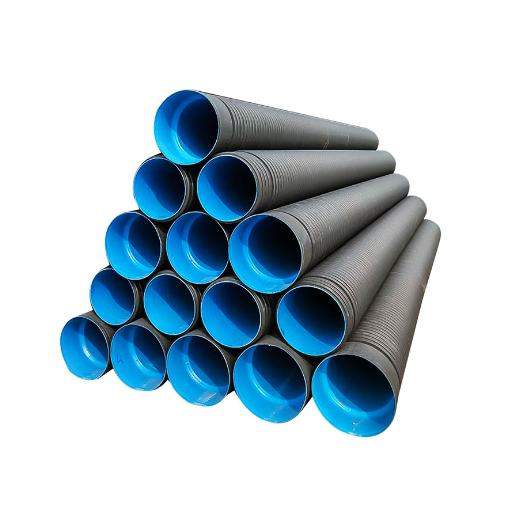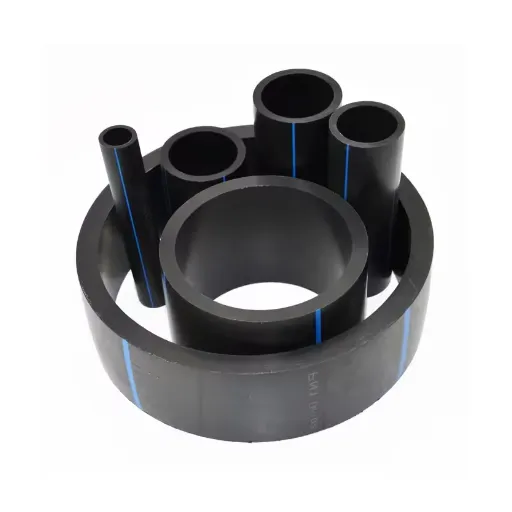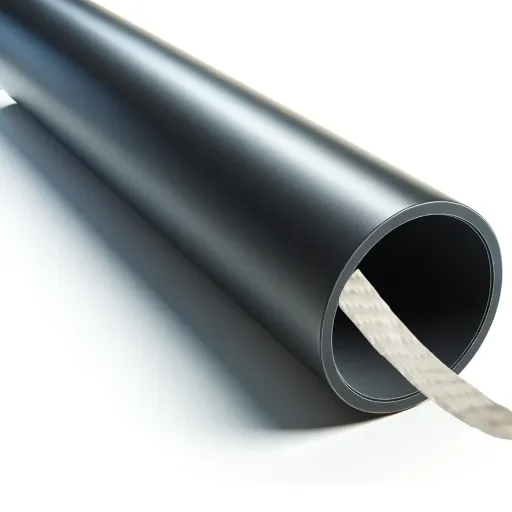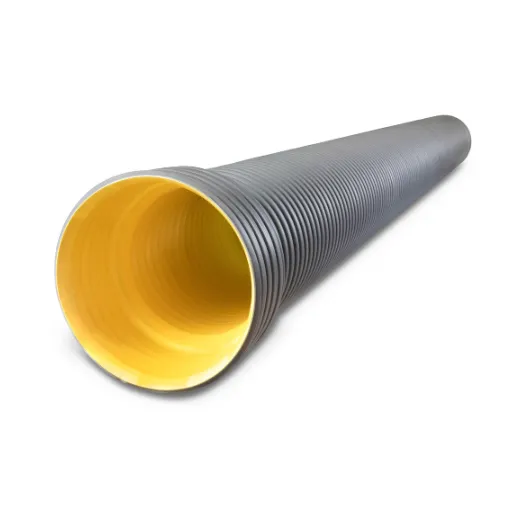High-Density Polyethylene (HDPE) double wall containment pipe systems have become a pivotal solution in industries requiring reliable, durable, and safe fluid transport. Whether you’re managing chemical containment, wastewater systems, or fuel management, these advanced piping systems offer unparalleled performance in both environmental protection and operational efficiency. This guide dives deep into the features, benefits, applications, and technical considerations of HDPE double-wall containment pipe systems. By the end of this comprehensive article, you’ll have a clear understanding of why these systems are a top choice for modern infrastructure projects, as well as how to select and implement them effectively for your specific needs.
What is HDPE Double Wall Pipe and How Does it Work?
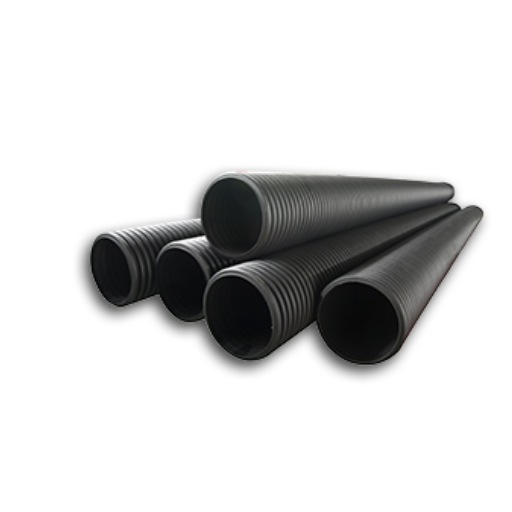
Understanding High-Density Polyethylene Double Containment Pipe
There are engineered solutions, such as High-Density Polyethylene (HDPE) double containment pipe systems, which safeguard against chemical spills and environmental damage. These systems comprise two pipes arranged in concentric circles: the inner carrier pipe and the outer containment pipe. They function together to ensure the safe movement of risky or delicate substances. The inner pipe mostly carries the material, while the outer pipe forms a barrier to contain any leakage or rupture that may occur in the inner layer.
Opting for thermoplasty fusion is more advantageous than using mechanical fastening methods as it eliminates the need for additional components that could be potential sources of leaks. Due to HDPE’s lightweight and exceptional chemical resistance, it is ideally applied for the construction of biofuel waste management tanks. The fusion of the joints ensures that no leaks will occur as a result of corrosion or physical damage over time, which is highly important for storing chemicals. Being able to detect leaks in real-time increases the reliability of using HDPE double containment piping for monitoring systems used in industries such as oil and gas, chemical manufacturing, and wastewater treatment.
Not only do these piping systems offer ease of compliance for environmental standards, but also serve as a reliable solution for infrastructure projects when combined with precision engineering and the material properties of HDPE.
Differences Between Double Wall, Dual Wall, and Single Wall HDPE Pipe
Each of the double wall, dual wall and single wall HDPE configurations varies in structural design and application for specific engineering requirements.
- Single-Wall HDPE Pipe: These pipes possess a single layer made of high-density polyethylene(HDPE) material, thus making them flexible and lightweight. The pipes serve well for agricultural drainage, stormwater management, and low-pressure fluid transport. Due to the economic benefits and ease of installing single-wall pipes, these pipes are often used. However, due to being more prone to external pressure, single-wall pipes require proper bedding to avoid deformation or damage if buried.
- Dual Wall HDPE Pipe: Dual wall HDPE pipes come with two layers, a smooth inner wall improving flow efficiency and an outer wall resembling corrugation for added strength. The design of these pipes takes into account both durability and hydraulic performance. Hence, they are suitable for high flow drainage, culverts, and storm sewers. The corrugated exterior helps resist external loads while the smooth interior helps reduce friction, allowing for optimal long-term functionality under demanding conditions.
- Double Wall Containment HDPE Pipe: Double wall HDPE pipes, also called double containment pipes, are specially designed for use where an extra safety barrier is needed. This system includes an internal carrier pipe and an external containment pipe. The internal pipe carries the main fluid, and the external pipe is an additional safety feature that contains any possible leaks, preventing hazardous chemicals or wastewater from seeping into the environment. This type of dual-layer piping is very important for industries with tough environmental requirements, such as industrial wastewater systems and chemical processing, as it ensures dependability and compliance with legal frameworks.
Each type of HDPE pipe is tailored to meet distinct operational requirements, including construction, fluid handling, and safety features. As such, selecting the appropriate configuration should take into account technical specifications about pressure loads, risk factors from the environment, and performance over time.
Key Components of HDPE Double Wall Pipe Systems and Fittings
Durable side pipes systems have several vital components; each designed for optimal efficiency, longevity, and reliability, these include the inner smooth wall, which allows fluid to flow freely, and the bolt-oration cased outer wall that has corrosion resistant and super structurally strong, protective properties. The two-layer pipe construction increases flexibility while maintaining necessary structural integrity in high-load applications.
Components made for HDPE double wall pipes, such as couplers, elbows, and tees, are tailored to provide seamless connections between non-branching sectional piping and maintain robust system integrity. Anti-leak mechanisms like rubber gaskets or welded joints heighten seal strength while providing resistance to environmental stresses, like soil movement or chemical exposure. Additionally, they meet tough performance criteria; they undergo rigorous stress testing, including calibration for changes in load bearing, thermal noise-induced expansions or contractions, and long-term operations.
Integrating intelligent monitoring technology for real-time monitoring of flow dynamics, pressure, as well as system structural weakening decreases system maintenance requirements. The lifespan of the system undergoes extension to be accompanied by harsh impact testing that enhances engineering alongside advanced materials to meet industry challenges, using strong, adaptable materials to tackle emerging environmental concerns, using reinforced HDPE double wall pipe configurations.
What Are the Benefits and Applications of HDPE Double Containment Pipe?
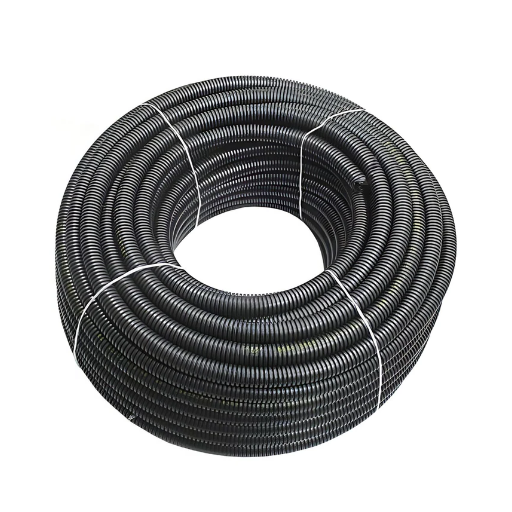
Corrosion Resistance and Chemical Compatibility of HDPE Piping Solutions
High-Density Polyethylene (HDPE) piping systems are praised due to their superior corrosion resistance and their ability to withstand a wide range of chemicals. Unlike conventional metal piping which uses corrosive materials, HDPE does not suffer from oxidative and galvanic corrosion due to its unique structure. It can bear chemical attacks while maintaining its integrity in saline solutions, bases, and acids.
Even under extreme conditions of high temperatures, HDPE pipes maintain their integrity due to their structural molecular composition. Their reliability is also guaranteed due to many supporting HDPE standards, which ensure its devotion for harsh usage. An example of this is using HDPE double containment systems in industrial processing plants to secure employee and environmental safety against exposure to dangerous chemicals.
Also, because HDPE piping is smoother than metal pipes, the chance of material accumulation and scaling, frequent occurrences in abrasive chemical settings, is lower. This reduces clogging and helps keep flow rates steady over time. These properties make HDPE critical in wastewater disposal systems, petrochemical plants, and farming crop irrigation systems, where harsh chemicals are commonly found.
Leak Detection and Containment Features in Dual-Wall Systems
A dual wall system is fabricated to meet the strict monitoring and containment frameworks of challenging industries. This wall integration feature has Interstitial spaces between inner and outer walls, which permit the installation of leak detection systems such as sensors or monitoring probes. These technologies allow for real-time stream data monitoring and give early warnings when there are breaches. Most systems utilize electronic monitoring devices that detect changes in pressure, fluid conductivity, as well as temperature in the interstitial layer, which instantaneously alert when an abnormality is recorded.
To achieve the needed environmental protection while still meeting the set guidelines, these systems are contrived with secondary means of containment. This secondary layer serves as an additional safeguard to contain any spills that might occur and guarantee that no leakage escapes into the environment even under some of the most harsh conditions. The materials incorporated into these systems, such as high-density polyethylene (HDPE), offer unparalleled resistance against chemicals and structural damage, making them reliable for long-term demand in chemical processing, fuel storage, and even wastewater management.
Using these modern functions, dual wall systems greatly improve operational safety while lowering maintenance expenses. Additionally, further developments in sensor technology and digital monitoring systems continue to enhance leak detection system capabilities, supporting predictive maintenance strategies and improving system performance.
Common Applications for HDPE Double Wall Pipe in Various Industries
The versatility of HDPE double wall pipe makes it a profound and flexible solution across different industries. Its chemical-resistant properties, durability, and integration with modern monitoring systems make it an astounding tool throughout various applications. Below are some common applications across various sectors:
- Water Runoff Management: Urban places and industrial areas have stormwater drainage systems in place and utilize HDPE double wall pipe on a wide scale. It has enduring structural integrity along with resistance to corrosion which makes it an ideal for controlling surface water runoff.
- Farm Drainage Transportation: These pipes are used to subsurface drain soil in the agricultural field to improve soil conditions. Due to harsh environmental conditions, their lightweight construction allows rapid installation along with enduring performance under varying soil pressures.
- Municipal Plumbing Systems: Pipes in the sewage infrastructure of municipalities are extensively used because of their watertight joints and chemical-resistant capabilities. Unlike other options, these pipes have the best durability under aggressive wastewater conditions.
- Business Mining Related Activities: For the purpose of disposing of waste water, managing tailings, and transporting slurry, HDPE double wall pipes are used. Handling abrasive mining byproducts is made more reliable with the high abrasion resistance of HDPE.
- Industrial Fluid Conveyance: These pipes are utilized in the manufacturing as well as food processing industry for the movement of different chemicals and liquids. The ability to withstand severe thermal and chemical stress guarantees sustained utility for enduring operational conditions.
- Road and Highway Drainage: During highway construction, the management of subsurface and roadside water drainage is often done with HDPE double-wall pipes. Their capacity to sustain heavy traffic secondary loads while maintaining utility over long periods is also important to infrastructure works.
Innovation in these sectors is fast-tracking the growth in the adoption of HDPE double wall pipes, as these systems are increasingly designed to meet new industrial challenges. They have high reliability and flexibility, low environmental impact, and construction, making them crucial for modern engineering design.
How to Properly Install HDPE Double Wall Pipe Systems?
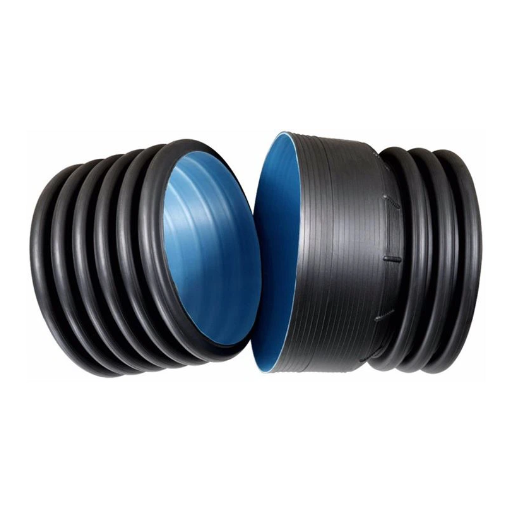
Step-by-Step HDPE Double Wall Pipe Installation Guide
- Site Preparation: First, thoroughly clean and level the site where the installation will occur. Make sure the trench is dug to the depth and width specified in the project design, paying special attention to the slope grade for adequate flow. Look for any soft or loose soil that can cause movement, and then place padding material like compacted gravel or sand to support the pipe structurally.
- Inspection of Pipes and Fittings: Prior to installation, check the HDPE double wall pipes and fittings for any visible damage, defects, or dirt that can affect functionality. Ensure the dimensions, markings, and other aspects in consideration achieve the project’s criteria. All procedures for carrying the items should be observed so as not to inflict any impacts or scratches that can alter the pipe’s structure.
- Placement of Pipes: Place the first section of the pipe in the trench with care. Ensure the house slope is as described, as opposed to something happening to the slope that will introduce a new flow structure. It is important that the bell and spigot ends, which will be solidly attached, match the previous pipe into the extrusion of the opposite pipe. Pipe bending that taxes the pipe’s maximum deflection limit is deemed acceptable; any more flexible bending will result in system failure.
- Joining the Pipes: Respectively, the legs were switched on the stick. The crucial step these systems implement for the cooperating parts is cleaning out the gasket groove left on the coupling of the pipe. Install the rubber gasket appropriately on the joint and lubricate both the gasket and the part of the coupling to enhance the ease of completion of the joining action while preventing leaking of water. The joining action is done by manually pushing the spigot into the bell end utilizing the suggested tools. Care should be exercised not to over-torque the tools so the warranty seal at the bottom part of the pipe is not obliterated.
- Backfilling Process: Following alignment of the joints and verification that the pipes sit properly, commence with the backfilling process using an appropriate aggregate. Equally and uniformly compact the backfill to give it aesthetic features while in layers to prevent uneven pressure on the pipe. Refrain from using sharp material or oversized boulders that may compromise the walls of the pipe.
- Final Inspection and Testing: As a wrap-up procedure, attempt the final scrutiny of all the sections to ascertain that no vital component was forgotten while cross-checking for damage to any parts that were handled during the build cycle. Perform the integrity checks by conducting pressure and leakage tests, if essential, after integrating all parts. All proceedings should be logged under the undertakings of the report for the sake of the policies of project.
Following these specific guidelines while observing the relevant standards enhances the performance, durability, and service life of HDPE double wall pipe systems, thereby supporting sustainable infrastructure activities para omr.
Fusion and Electrofusion Joint Techniques for HDPE Pipe
The techniques of jointing by fusion and electrofusion rest on the foundation of precise, dependable, high-quality connections in an HDPE pipe system. In the case of fusion welding or butt fusion, both the ends of the pipe are simultaneously heated to the point that they turn into liquid. After providing adequate heating, the hot ends of the pipe are brought together with a certain force to allow the material to fuse as it cools. This technology performs exceedingly well for applications that demand durability in conditions of extreme pressure and stress over time.
Electrofusion fittings have their distinct method to merge piping. They use specialized fittings that contain the heating elements. An electric current can be passed through the fitting, which will cause it to heat up and melt both the outer surface of the fitting and the surface of the pipe to bond strongly upon cooling. This method becomes most useful when dealing with pipes in hard-to-reach places or pipes that use different diameters. Also, due to the automation, control of the integrity of the joint is possible through monitoring temperature and time of fusion provided during the process.
Each of the techniques lay out strict procedural steps for maintaining consistent quality and performance. Surface preparation is critical in both methods, including cleaning the pipes and fittings of any contaminates and proper alignment during welding. Traceability and project compliance is guaranteed with the use of advanced instruments such as data loggers that record relevant parameters during electrofusion. By taking such approaches, HDPE systems can satisfy modern requirements for sustainable infrastructure by improving durability, reliability, and longevity.
Common Installation Challenges and Troubleshooting
Adhering to standards while achieving optimal performance in HDPE piping systems requires addressing various installing challenges. One common problem is improper pipe alignment which can adversely affect the integrity of the joint and lead to leakage or mechanical failure. This problem is usually a consequence of insufficient groundwork or inadequately prepared operators in regard to the technology of fusion.
Equally as important is coping with contamination of joining surfaces. The presence of grease, dirt, and moisture poses serious problems to pipe bonding. All these factors can be minimized by the use of proper workplace cleanliness policies, together with the use of approved cleaning substances. In addition, some uncontrollable environmental factors,s as extreme temperature, may greatly reduce the quality of the fusion process. For example, extreme cold may unsustainably increase the amount of heating time necessitated for proper weld formation, while high temperatures may rapidly cool the joint before it is finished.
Like other electrofusion processes, the application of the voltage and the functioning of the equipment may also present problems. These issues can be avoided by regularly maintaining fusion equipment, inspecting parts, monitoring voltage settings, and adjusting settings before use. It is now commonplace to monitor the data collected for devices during the fusion process, as it provides the needed evidence for the capture of anomalies, which aids in prompt signal detection.
System reliability and compliance with industry specifications can be enhanced with reduced required repairs and extended system lifespan when advanced troubleshooting techniques are incorporated by installers for tailored custom challenges associated with HDPE systems.
What Are the Technical Specifications and Standards for HDPE Double Containment Pipe?
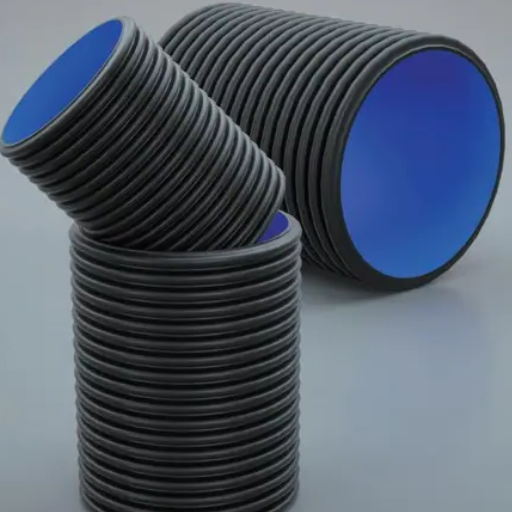
Understanding Soil Tight vs. Watertight HDPE Double Wall Pipe
HDPE double wall pipes have a variety of distinct joint configurations to serve particular project needs, primarily divided into two categories: soil-tight and watertight connections. Soil-tight joints are manufactured to prevent soil particles from penetrating a pipe’s structural cavity void, thus preserving integrity, functionality, and preventing earth penetration in applications where a full seal is not needed. Such joints make use of a very effective bell-and-spigot system paired with gaskets, which allows them to be economically effective while still providing a reasonable degree of soil intrusion resistance.
In comparison, watertight HDPE double wall pipes are designed with an even greater seal. They can stop the seepage of water and other fluids in either direction. This level of sealing effectiveness is imperative for construction designs related to stormwater management, wastewater conveyance, or any other system that needs to contain liquids under changing pressures.
The choice between soil-tight and watertight joints is determined by the specific site features such as soil type, groundwater elevation, and zoning codes. For example, in regions with high groundwater pressure or in ecologically sensitive areas, they need watertight performance to lessen the possibility of leakage and environmental contamination. On the other hand, soil tight systems are generally adequate for regions that have low hydrostatic pressure and standard drainage requirements, where cost considerations dominate. Therefore, knowing these guidelines enables effective and economical design while ensuring that the requirements of using HDPE double wall pipe systems are met functionally and legally with reliable performance, strength, and endurance.
Engineering Considerations for HDPE Double Wall Piping Systems
An important engineering consideration to evaluate is how the pipes perform under different stress levels, which include live, dead, and impact loads. Due to its corrugated exterior and smooth interior, HDPE double-wall pipes are designed to endure significant external pressures. The ability to flex is vitally important for the smooth interior section, but also contributes to the HDPE’s resistance to overpowering deformation due to soil, traffic, and superimposed load, resulting in soil overburden. Traffic or soil overburden can cause huge deformation.
Moreover, other very important factors include how extreme temperature changes would affect the soil as well as any metals surrounding it. The HDPE material possesses exceptional thermal stability. Its functional temperature range is normally taken to be -40°F to 140°F, qualifying it to be used in various climates as a thermal insulator. Even so, rates of expansion and contraction need to be given special attention during installation, particularly during long straight sections of the pipe. Professional guidance frequently suggests providing adequate construction joints or stretch joints that are meant to reduce stress from thermal contractions or expansions.
Finally, novel features of sustainable design are porous materials from which the HDPE pipe systems are made. These are taking on a larger role as a fundamental hallmark of HDPE pipe system specificatons.A high percentage of post-consumer HDPE products are recycled due to their convenient usage factors. This helps to further lessen emissions while following the regulations set.
Applying these factors allows engineering teams to maximize the design and performance potential of HDPE double-wall piping systems across multiple industries.
How to Maintain and Troubleshoot HDPE Double Wall Pipe Systems?
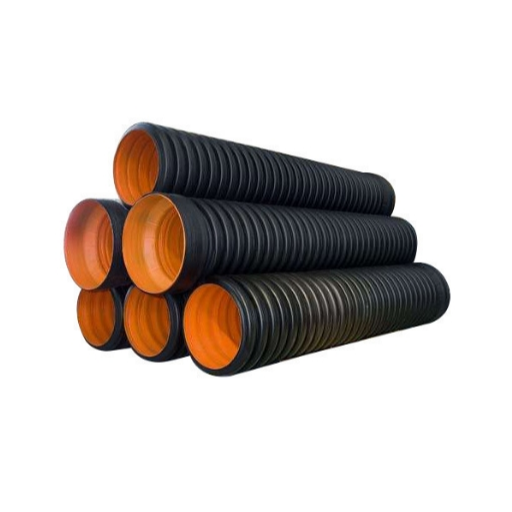
Maintenance Requirements for HDPE Double Containment Pipe
Maintaining an HDPE double containment pipe system requires regular checks and following industry standards to ensure its longevity and reliability. Some of the dismantling activities include visual checks of the containment layer to look for leaks, damage, wear and tear, and deformities. Other checks, such as Ultrasonic or pressure testing, can further assist in examining more complex setups for material degradation, joint separation, and structural integrity.
Sediment and chemical residue build-up should be addressed regularly to maintain fluid flow within the inner pipe. Cleaning solutions must not react with HDPE, otherwise, section breakdown will occur. Changes in operating pressure, temperature, and the chemical makeup of the transported materials will impact the rate of wear. Therefore, maintenance schedules need to be revised and planned accordingly.
Leak detection sensors and pressure monitoring systems that are placed within the containment layer aid in leakage identification and mitigation, expediting the response to emerging problems. To maintain functionality and precise corrections, these sensors and monitors have to undergo regular scheduled checks to confirm them being checked and calibrated to the set intervals.
Conducting updates to maintenance procedures per recommendations from the industry and manufacturers will ensure compliance with the most recent standards and developments. Failure risk can be reduced while the life and operational efficiency of HDPE double containment pipes can be increased when operators put into effect thorough and effective maintenance strategies.
Detecting and Repairing Leaks in HDPE Dual-Wall Systems
Detecting the leaks in dual-wall HDPE systems can be very crucial to avoid operational failure, along with the issues concerning environmental safety. The latest techniques in detection use high-tech monitoring equipment, acoustic sensors, pressure surveillance systems, and even infrared thermography. Acoustic sensors make it easier to find leaks as they detect sound waves produced by fluids escaping through a system, thus allowing high precision in locating the leak. Flow pressure inconsistencies that suggest the presence of a breach are detected by pressure monitoring systems. On the other hand, infrared thermography employs thermal imaging to sense temperature decreases and increases due to leakages, which may not be detected due to a lack of visibility.
When a leak is detected, first, the affected area or segment should be isolated to minimize fluid escape. This will help in reducing the system downtime as well as safeguard the environment. Repairs consist of taking off the part that needs fixing and substituting it with a new piece of pipe. In HDPE systems, to restore structural integrity and ensure the elimination of weak points that could result in future leaks, port fusion techniques are widely used. Instead of just utilizing standard repair techniques, system durability can be strengthened by applying advanced sealing systems along with monitoring devices after the sealing process.
Furthermore, employing data analytics for leak prevention is becoming increasingly useful. Operators can predict upcoming trouble spots and act to mitigate them before they become larger problems by analyzing operational data trends along with historic wear patterns.
Extending the Lifespan of Your HDPE Double Wall Pipe Installation
To ensure the optimal service life of HDPE double wall pipe installations, the approach must include proper design, precise execution, and extensive maintenance. Under bedding, backfilling, and filling procedures that are performed during installation must allow for uniform load distribution and prevention of any pipe deformation.
Selection of materials also plays a vital role; using quality resin with UV inhibitors enhances the capability for weather exposure and sunlight. After carrying out the installation, frequent inspections with non-destructive testing procedures such as ultrasonic or video pipe inspection can reveal the presence of early signs of gradual damage, like abrasion or chemical microbiological attack.
Moreover, monitoring advanced technologies like pressure and flow meters combined with performance monitoring enables remote assessment of real-time performance. The monitoring systems can notify operators when conditions deviate beyond predefined limits, so prompt assessment can be done. This method, paired with predictive maintenance, helps sustain operational performance while degrading the resiliency of HDPE double wall pipe systems and refines, predicting longevity, even in harsh environments.
References
Frequently Asked Questions (FAQs)
Q: What makes HDPE dual-wall pipe systems an excellent alternative to reinforced concrete?
A: HDPE dual-wall pipe systems are considered an excellent alternative to reinforced concrete due to several key advantages. They offer superior corrosion and abrasion resistance, which significantly extends their service life in harsh environments. The lightweight nature of HDPE makes installation faster and more cost-effective, requiring less heavy equipment. Additionally, the bell and spigot design ensures water-tight connections, minimizing leakage risks. HDPE pipes are also more flexible than concrete, allowing them to withstand ground movement and settlement without cracking, and they provide better hydraulic performance with smoother interior walls that reduce friction and improve flow capacity.
Q: What types of fluids can be safely transported through HDPE double-wall containment pipe systems?
A: HDPE double wall containment pipe systems can safely transport a wide range of fluids, including potable water, wastewater, stormwater, industrial chemicals, and some petroleum products. They’re particularly well-suited for handling aggressive chemicals like sodium hypochlorite due to their excellent chemical resistance. The dual-containment design provides an additional layer of protection, making these systems ideal for environmentally sensitive applications or when transporting hazardous fluids. It’s important to consult the manufacturer’s chemical resistance charts or fittings manual to verify compatibility with specific chemicals, as concentration levels and temperature can affect long-term performance.
Q: What are the key benefits of corrugate design in dual-wall N-12 pipe systems?
A: The corrugated design in dual-wall N-12 pipe systems offers multiple significant benefits. The corrugated exterior provides exceptional structural strength, allowing the pipe to withstand heavy soil loads and traffic while maintaining its shape. This design dramatically increases the pipe’s ring stiffness compared to smooth-wall pipes of similar material thickness. The corrugations also create flexibility that helps absorb ground movement and seismic activity without damage. Additionally, the profile reduces material usage compared to solid wall pipes of equivalent strength, making it a more cost-effective and environmentally friendly solution. When combined with a smooth interior wall, the corrugated design delivers the perfect balance of structural integrity and hydraulic efficiency.
Q: How does the plastic composition of double-wall containment pipes affect their durability as a conduit?
A: The plastic composition of double-wall containment pipes, typically high-density polyethylene (HDPE), significantly enhances their durability as a conduit in several ways. HDPE is naturally resistant to corrosion, eliminating concerns about rust or degradation that affect metal pipes. This material is also highly resistant to chemical attack, making it ideal for transporting aggressive industrial fluids. The plastic composition provides excellent abrasion resistance, extending service life in applications where particulate matter is present. Additionally, HDPE’s natural flexibility allows these pipes to withstand ground movement, freeze-thaw cycles, and impact without cracking. Many manufacturers, like Advanced Drainage Systems, incorporate UV stabilizers and antioxidants into their plastic formulations to further enhance weather resistance and prevent degradation from environmental exposure.
Q: How do installation requirements differ for HDPE dual-wall pipe compared to traditional materials?
A: Installation requirements for HDPE dual-wall pipe differ from traditional materials in several significant ways. Unlike concrete or metal pipes, HDPE pipes are lightweight, reducing the need for heavy lifting equipment and accelerating installation. The bell and spigot design allows for quicker connections without specialized welding or mechanical joining in many applications. Trenching requirements may be less stringent due to the pipe’s flexibility and impact resistance. However, proper backfill and compaction are critical to ensure the corrugated exterior performs as designed. Temperature considerations are more important with plastic pipes, as thermal expansion and contraction must be accommodated. Manufacturers like ADS provide detailed installation manuals that specify bedding requirements, backfill materials, and compaction levels necessary for optimal performance and to maintain warranty coverage.
Q: What are the limitations of HDPE double-wall containment pipe systems for fluid transport?
A: HDPE double wall containment pipe systems have several limitations for fluid transport that should be considered. Temperature constraints are significant, as standard HDPE is generally limited to operating temperatures below 140°F (60°C), making it unsuitable for high-temperature applications without special formulations. Pressure ratings are typically lower than those of solid wall pipes or metallic alternatives, limiting use in high-pressure systems. UV exposure can degrade HDPE over time if pipes are installed above ground without proper protection. While chemically resistant to many substances, certain concentrated solvents and oxidizing chemicals may cause issues, requiring careful review of chemical compatibility charts. Additionally, HDPE has a higher thermal expansion rate than metal or concrete, necessitating special design considerations for applications with significant temperature fluctuations. Lastly, these systems generally require more specialized fittings and connection methods than traditional piping, potentially affecting stock availability and installation complexity.



